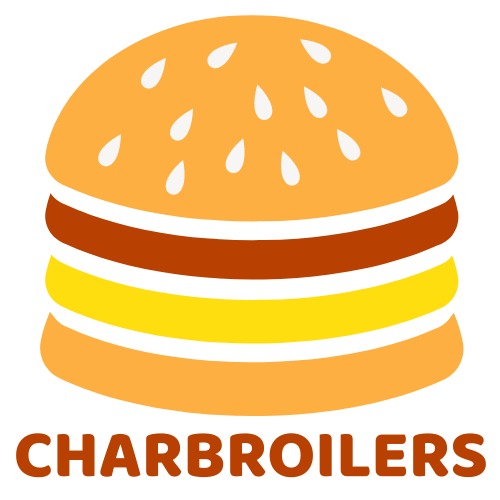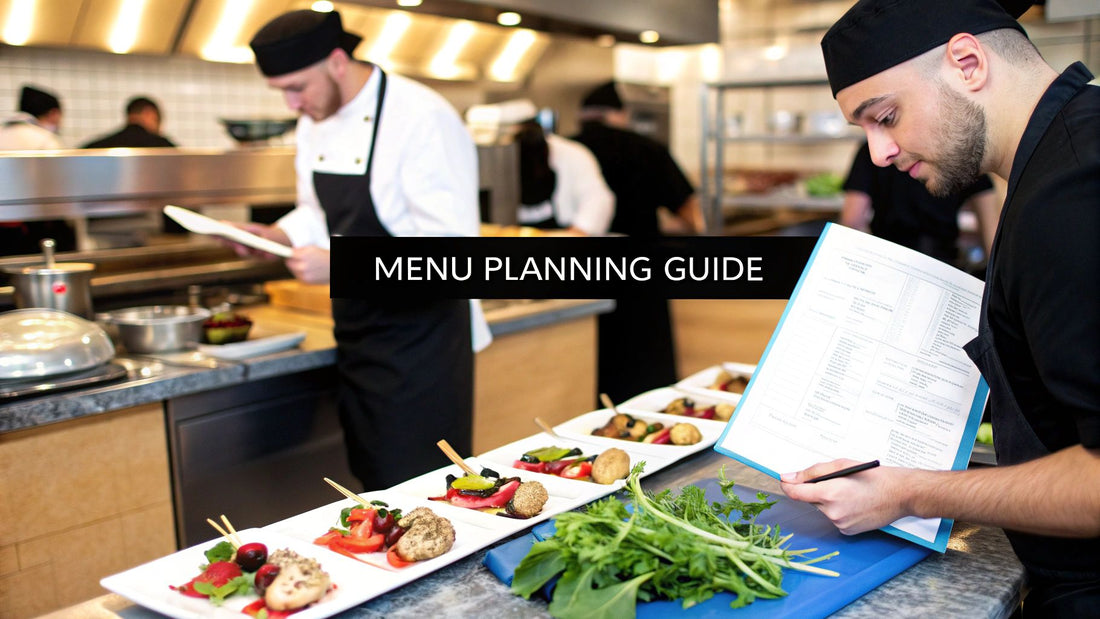
A Guide to Menu Planning for Restaurants
Share
Long before a single recipe is finalized, the foundation of a successful restaurant menu is laid. It all starts with a crystal-clear culinary vision. This vision is your blueprint, guiding everything from sourcing ingredients to how a dish looks on the plate. Get this right, and every item on your menu will tell a cohesive story that pulls your ideal customers in.
Defining Your Restaurant's Culinary Vision
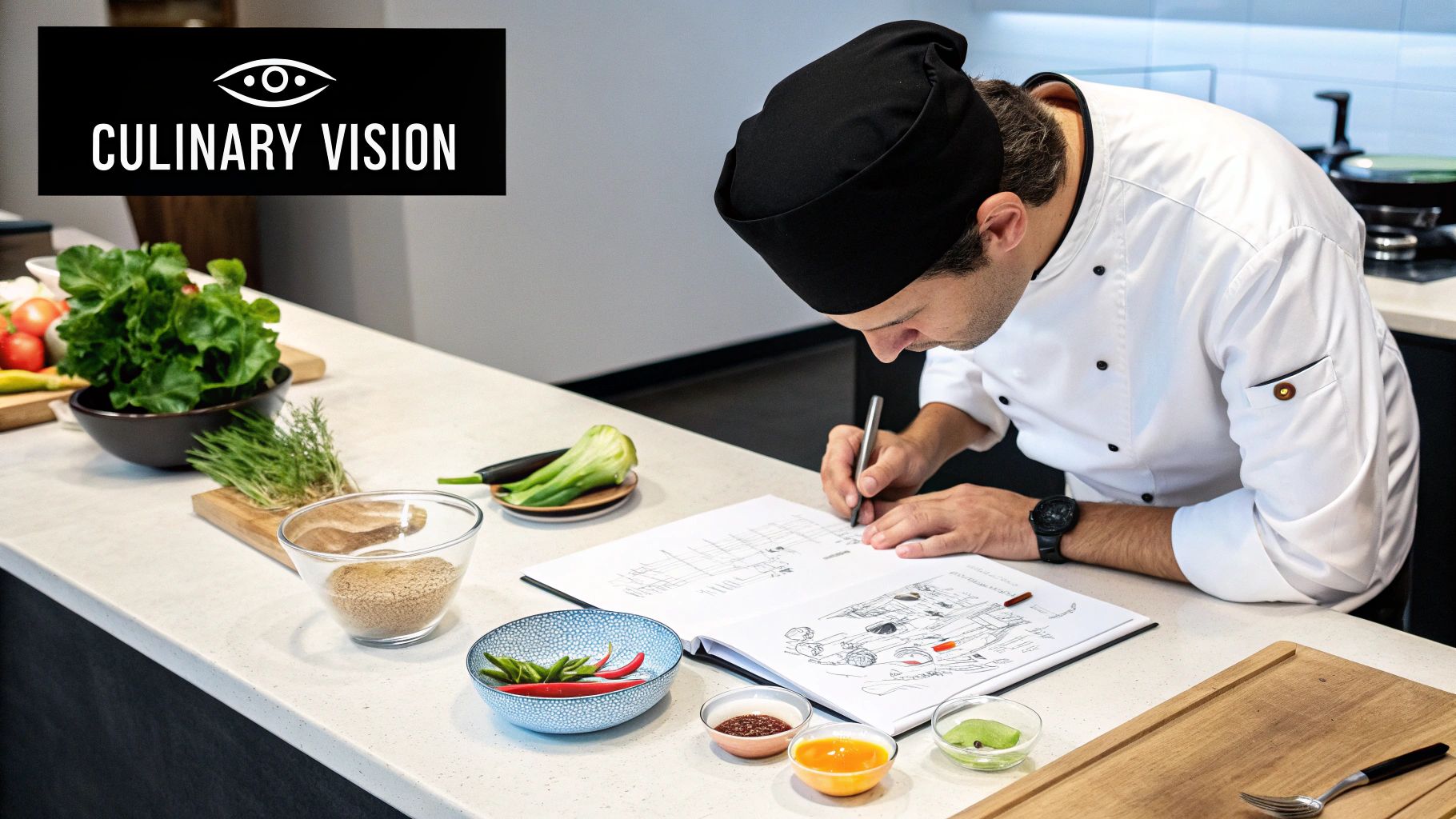
Before you even think about food costs or what kind of charbroiler you need, you have to define what your restaurant is all about. Your culinary vision is the soul of your business. It's how you translate your brand’s unique story into a tangible dining experience that people will remember.
Every decision you make from here on out will stem from this vision. It’s what keeps you consistent and builds a loyal following from the very first visit.
Think about it: a rustic, farm-to-table bistro and a sleek, modern sushi bar are telling two completely different stories. Their menus have to reflect that, right down to the font they use and the names of the dishes.
Find Your Niche and Own It
The real first step in planning a killer menu is locking down your niche. Are you going for authentic, region-specific Thai street food? Upscale, modern comfort food? Or maybe a hyper-local concept built entirely around what's in season? A well-defined niche helps you cut through the noise in a crowded market and attract customers who are looking for exactly what you offer.
To nail down your niche, you've got to ask the right questions:
- Who are you cooking for? Your target audience is everything. Busy professionals grabbing a quick, healthy lunch have totally different needs than a family celebrating a big anniversary.
- What's your story? What makes your restaurant special? Maybe it's an old family recipe, a deep passion for sustainable farming, or a wild fusion of cultural flavors you came up with.
- What's missing in your market? Take a hard look at your local competitors. Instead of just copying what seems to be working for them, find the gaps. Is there an unmet demand for high-quality vegan options? Is no one doing authentic Neapolitan pizza the right way?
To make this a bit more concrete, you can use a simple decision-making tool. It helps you weigh different ideas against the factors that actually matter for your business.
Core Menu Concept Decision Matrix
| Concept Theme (e.g., Italian, Vegan, Fusion) | Target Audience Appeal | Ingredient Availability | Operational Complexity | Profit Potential Score |
|---|---|---|---|---|
| Farm-to-Table Italian | High with foodies/families | Seasonal, requires strong local supplier relationships | Medium; depends on menu simplicity | 8/10 |
| Quick-Service Vegan Bowls | Growing, strong with millennials/Gen Z | Generally good, some specialty items may vary | Low to medium; prep-heavy but fast service | 9/10 |
| Upscale Japanese Fusion | Niche but high-spending audience | Requires specialty suppliers, can be costly | High; requires skilled chefs and precision | 7/10 |
By scoring your top ideas like this, you can move past gut feelings and make a strategic choice based on real-world factors.
Stay Ahead of Culinary Trends
Your vision can't exist in a vacuum; it has to connect with what people actually want to eat right now. Food trends, driven by everything from health consciousness to sustainability, have a huge impact on menu planning. For example, mentions of plant-based menu items in restaurants shot up by 27% globally between 2020 and 2023.
This isn't just a fad. It's why 70% of chefs now see menu innovation as a top priority for growth. You can dive deeper into these shifts by checking out industry analysis on current menu trends. Keeping a finger on the pulse ensures your concept feels fresh and relevant.
A cohesive theme is more than just aesthetics; it's a promise to your customer. When your menu, decor, and service all align with your central vision, you create a memorable and trustworthy brand experience.
Mastering Food Costing and Menu Profitability
Okay, you've nailed down your culinary vision. That's the fun part. Now comes the part that keeps you in business: turning that vision into a profitable reality. A menu full of amazing dishes that loses money with every sale is a fast track to closing your doors. This is where food costing isn't just an accounting task—it becomes your most powerful tool.
First things first, you need to know the exact cost of every single plate that leaves your kitchen. I’m not just talking about the steak or the fish. I mean everything. The pinch of finishing salt, the drizzle of oil, that single sprig of parsley for garnish. Every component adds up. This detailed breakdown gives you your plate cost, which is the bedrock for setting menu prices that actually build your business.
To get the bigger picture beyond individual plates, you'll want to get familiar with a restaurant profit margin calculator. Tools like this are a game-changer for understanding how your numbers work together.
Decoding Your Menu with Engineering
Once you have your plate costs dialed in, you can start what we call menu engineering. This isn't as complicated as it sounds. It’s a straightforward method for analyzing how profitable and popular each dish is, so you can stop guessing and start making decisions based on cold, hard data.
Every item on your menu will fall into one of four buckets:
- Stars: These are your knockout dishes. High profitability and high popularity. Customers love them, and they make you fantastic money.
- Plowhorses: Everyone orders these, but they have low profitability. They're your crowd-pleasers that keep people coming back, even if the margins aren't great.
- Puzzles: These dishes are great for your bottom line (high profitability) but for some reason, they just aren't selling (low popularity).
- Dogs: The duds. Low profitability and low popularity. They’re taking up space on your menu and tying up resources in the kitchen.
This isn't just an exercise in categorization. It’s a roadmap for action.
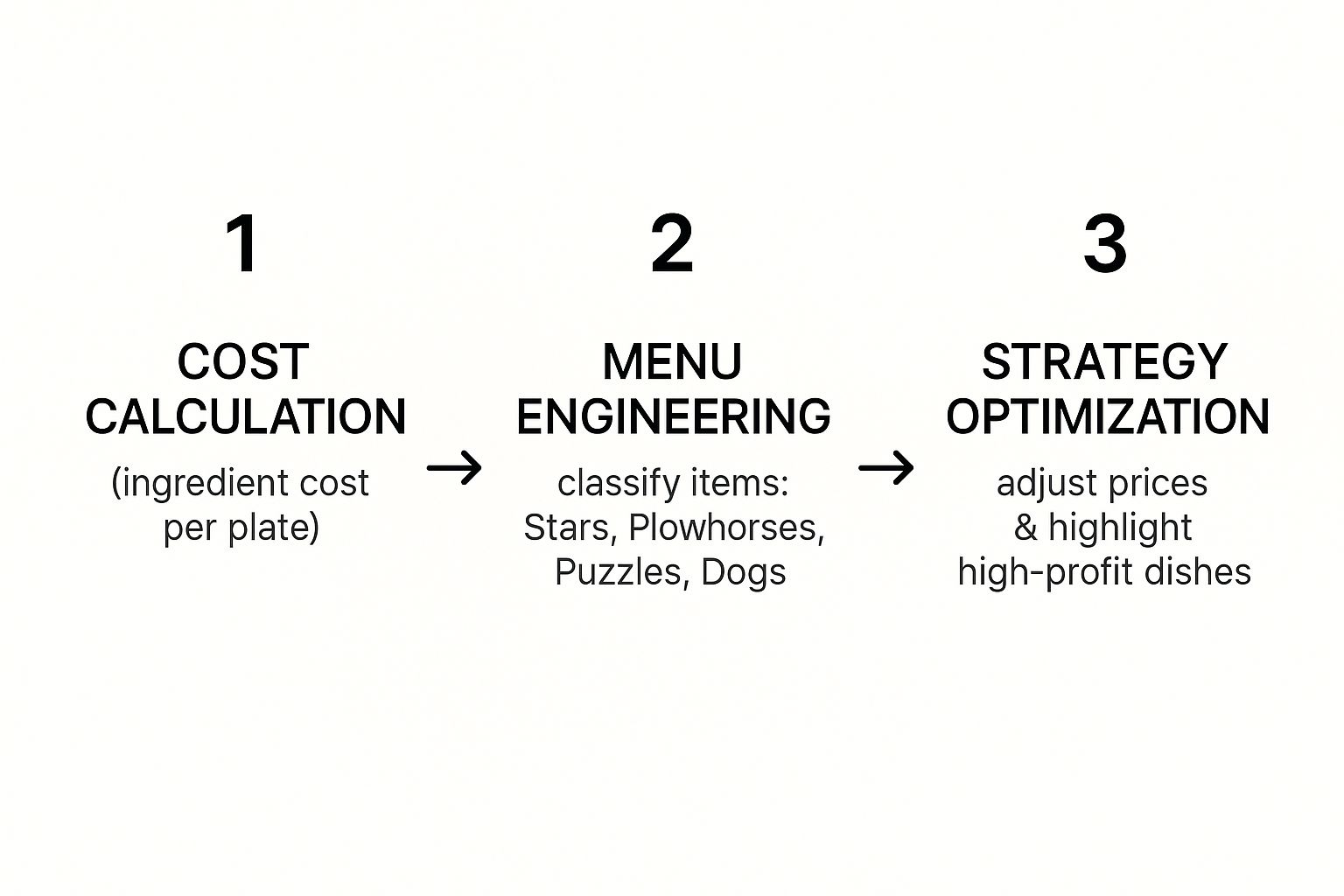
As you can see, figuring out your costs is just the starting line. The real power comes from classifying each dish and building a strategy around it.
Turning Data into Dollars
With this knowledge, you can start making moves that directly boost your restaurant's financial health. Your menu stops being a simple list of food and becomes one of your best sales tools.
For your Stars, the mission is clear: promote the heck out of them. Give them prime real estate on the menu, have your servers recommend them, and feature them in your social media posts. These are your golden geese.
A common mistake is ignoring Plowhorses. While their individual profit is low, their high volume means a small price increase or a minor reduction in their cost can have a massive impact on your bottom line.
Puzzles need a different tactic. They're already profitable, so the challenge is getting more people to order them. Try rewriting the menu description to make it more enticing, run it as a special, or train your servers on the key selling points.
And the Dogs? The best move is usually to just let them go. Cut them from the menu and free up that space—and your kitchen's attention—for dishes that actually make you money.
Building Your Strategic Supplier Network
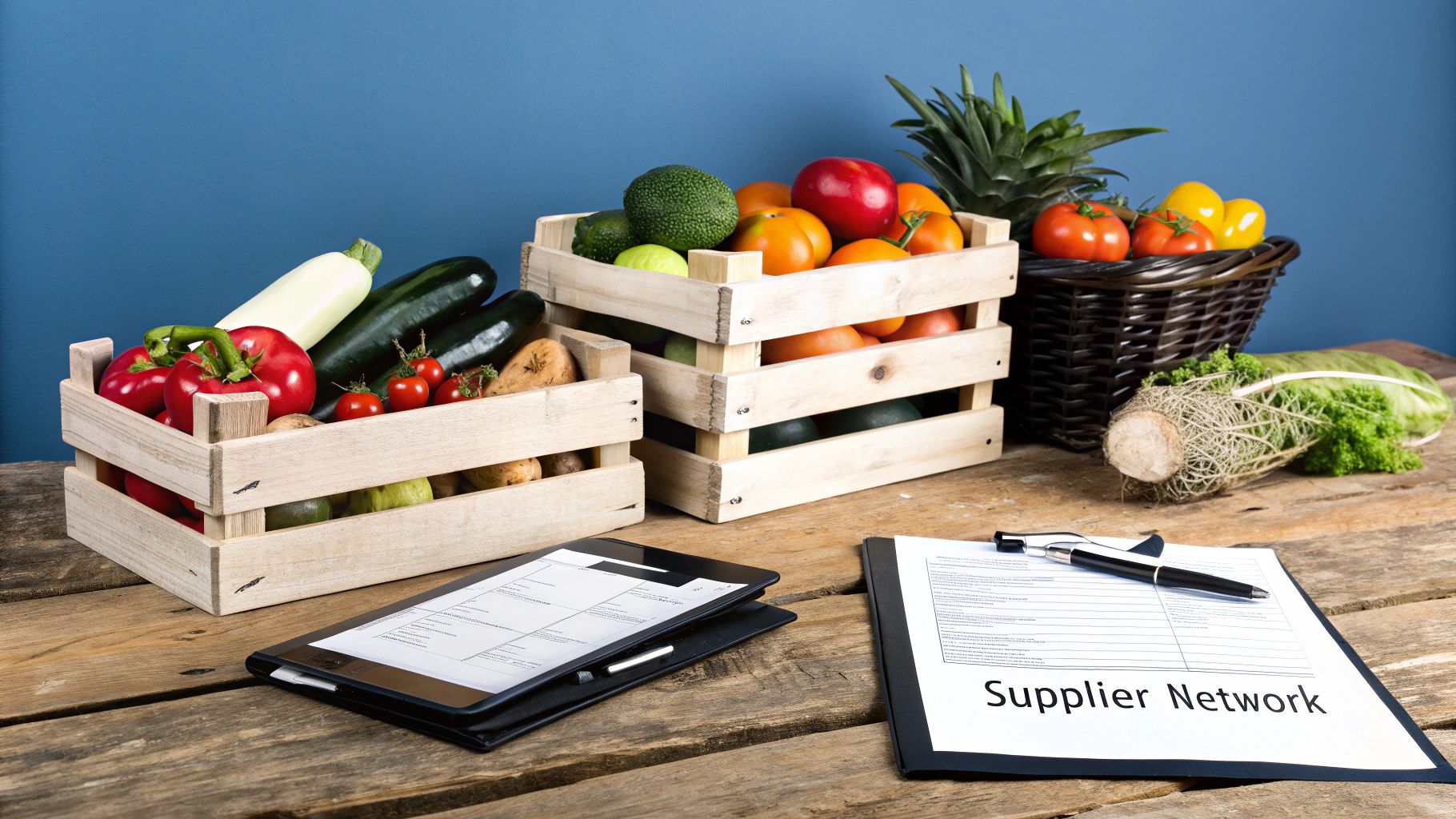
Let's be honest—the quality of your menu lives and dies by the quality of your ingredients. You can have the most perfectly costed dish in the world, but it all falls apart if the produce is wilted or the protein isn't fresh. This is why building a solid supplier network isn't just a task on your to-do list; it's the very backbone of your kitchen's success.
Think of these partners as an extension of your team. The right ones bring consistency, help you keep a lid on costs, and can even become a major part of your restaurant's story.
Finding Partners Who Align With Your Vision
Before you start making calls, look at your concept. Are you a farm-to-table bistro? Then you need to be building relationships with local farmers. Running an upscale seafood spot? Your top priority is a supplier with a flawless cold chain and direct lines to the freshest catches. The goal is to find people who get what you're trying to do.
A smart supply chain isn't about finding one perfect supplier. It’s about building a diverse team. You’ll likely need a mix:
- Large-Scale Distributors: These are your go-tos for the basics. Think flour, sugar, oils, and other staples. They offer competitive pricing and, most importantly, rock-solid reliability.
- Specialty Purveyors: Where do you get that amazing artisanal cheese or those imported cured meats that make a dish unforgettable? From a specialty supplier who lives and breathes that one product.
- Local Farmers and Producers: There's nothing better than shaking the hand of the person who grew your tomatoes. These direct relationships give you access to incredible seasonal ingredients and create a powerful marketing story that customers love.
Always vet your potential suppliers. Ask them for references from other restaurants in town. Grill them on their delivery schedules and what happens when something goes wrong. And never, ever sign on without getting samples to test yourself.
A strong supplier relationship is a two-way street. Pay your invoices on time, communicate your needs clearly, and be a good partner. That trust pays you back with better pricing, first dibs on special products, and flexibility when you’re in a jam.
Negotiating Contracts And Managing Inventory
Once you’ve found some good potential partners, it's time to talk business. A solid contract is what protects your margins and keeps the ingredients flowing. Get everything in writing: pricing, delivery schedules, payment terms, and exactly what your quality standards are. What happens if a case of lettuce arrives looking sad? That needs to be in the agreement.
The final piece of this puzzle is managing the inventory once it's in your building. Ordering too much leads straight to the trash can, but ordering too little means 86'ing a popular dish on a busy Saturday night. Dive into your sales data to get a real handle on forecasting your needs. Always use a "first-in, first-out" (FIFO) system to rotate your stock. It's simple, but it's the best way to cut down on spoilage.
This same level of operational discipline applies to outfitting your kitchen. When you’re sourcing everything from walk-in coolers to charbroilers, a comprehensive resource like a Dallas restaurant supply provider simplifies everything. By mastering both your ingredient pipeline and your equipment setup, you put yourself in the best possible position to protect your bottom line and serve up incredible, fresh food every single day.
Aligning Your Menu with Kitchen Capabilities
Your most creative culinary ideas can quickly become your worst nightmare if your kitchen isn't equipped to handle them. I’ve seen it happen. An ambitious menu that ignores the reality of your back-of-house will lead to slow service, stressed-out staff, and inconsistent food. It’s a recipe for disaster.
Successful menu planning for restaurants is really about building a bridge between your vision and what your team can flawlessly execute, even during the chaos of a Saturday night rush.
This means taking a hard, honest look at your kitchen's layout, equipment, and workflow. Every single dish you consider has to be evaluated not just for its taste and cost, but for its real-world operational impact.
Maximize Your Key Equipment
Your most valuable pieces of equipment should be the anchors of your menu. A high-quality commercial charbroiler, for instance, isn't just for cooking one signature burger. That’s a rookie mistake. It's a versatile workhorse that can be the foundation for a whole range of high-profit dishes.
Think about how that one piece of equipment can power multiple menu items:
- Signature Burgers: The obvious star, perfectly charred and full of flavor.
- Grilled Chicken Sandwiches: A lighter but equally popular option that uses the same station.
- Steak Entrees: From sirloins to ribeyes, maximizing the charbroiler's high-heat capabilities.
- Grilled Vegetable Sides: Adds a smoky, premium side dish that elevates any plate.
- Grilled Fish: Offers a healthier, yet flavorful, seafood choice.
By designing your menu around the strengths of your core equipment, you ensure you get the absolute maximum return on your investment. This approach also simplifies training and lets your line cooks become true experts on the most important stations.
The goal is to make every piece of equipment work hard for you. If a specialized machine is only used for one low-selling dish, it's occupying valuable space and capital that could be better used elsewhere.
Analyze Your Workflow and Station Load
Beyond the heavy metal, you have to consider the human element—the actual flow of your kitchen. Imagine the journey of each dish, from the prep station all the way to the pass. Does preparing one popular item create a bottleneck that slows down everything else?
Trace the steps required for each potential menu item. How much prep time is needed? Which stations will be involved? Can different components be prepped ahead of time without sacrificing quality? If you're looking to streamline your operations, it's worth exploring the different types of LA restaurant equipment that can seriously optimize your kitchen’s layout and efficiency.
A simpler, more focused menu is often the most effective. It's not just a gut feeling; the data backs it up. One survey showed that 20% of restaurant operators planned to reduce their menu size, with that number jumping to 24% for full-service spots. According to insights on restaurant innovation trends, this is a direct response to rising food costs and labor shortages. It proves that a lean menu is a smart menu.
Ultimately, a menu that works with your kitchen leads to faster ticket times, less waste, and a happier, more efficient team. That’s the operational secret to consistently delivering the quality your customers expect.
Designing a Menu That Sells for You
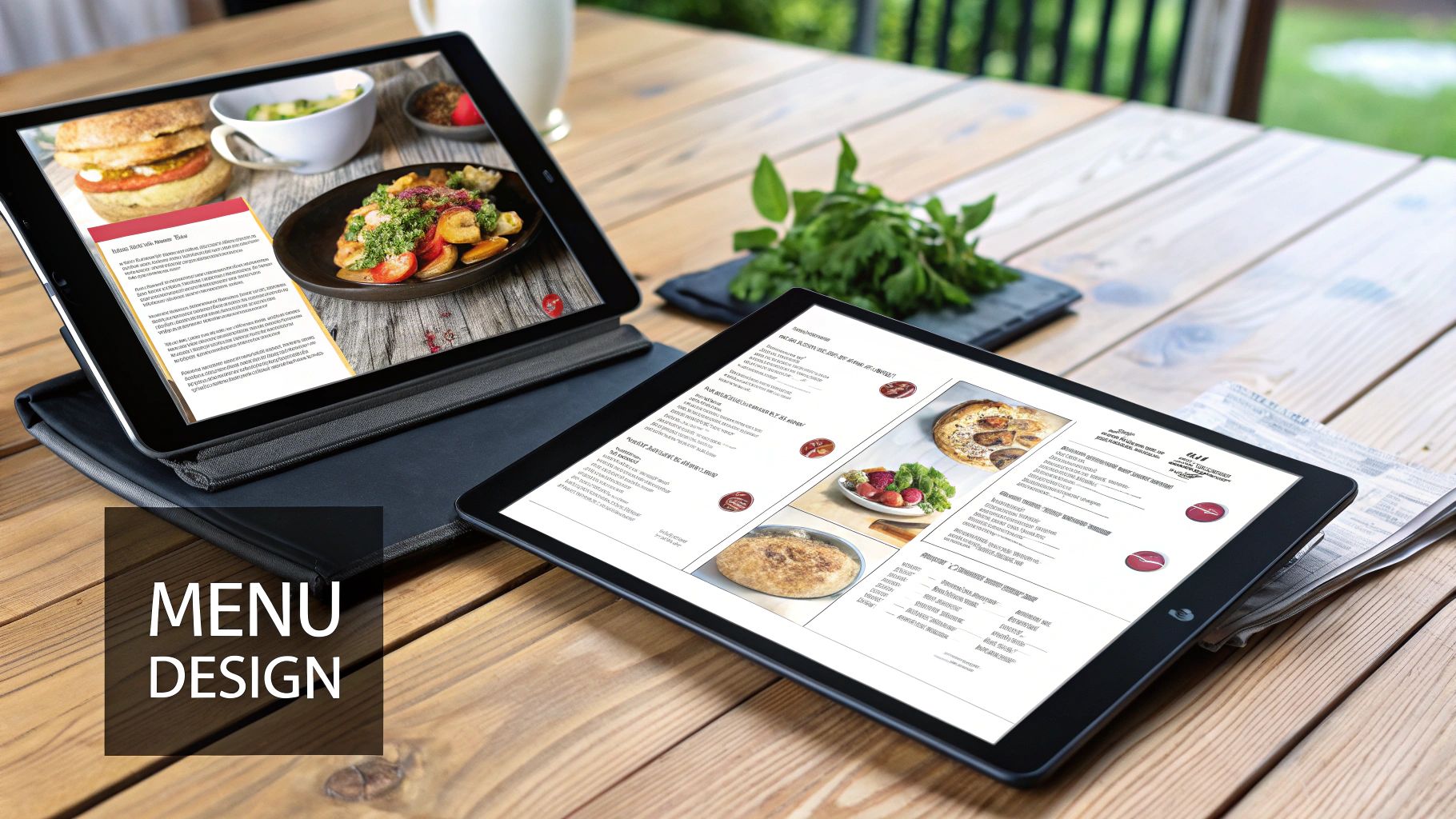
Think of your menu as more than just a list of what's coming out of the kitchen. It’s your single most powerful marketing tool once a guest is seated. A well-thought-out menu does the selling for you, using a bit of psychology to guide customer choices, push your most profitable items, and bump up that average check size.
It really boils down to understanding how people read a menu. It’s not like a book. Their eyes jump around, naturally landing on a few key spots first. We call this the 'golden triangle' in the industry. This is your prime real estate.
This is exactly where you want to feature your high-margin "Stars"—those dishes that are both popular and profitable. By placing them in the top right, center, and top left of your menu, you’re putting your best foot forward and drawing immediate attention to the items that make you the most money.
The Power of Words and Visuals
The descriptions you use are just as critical as the layout. "Chicken Breast" is boring. It does nothing to get someone's mouth watering. Now, "Pan-Seared Chicken Breast with a Rosemary-Garlic Glaze"? That paints a picture. Descriptive words make a dish sound like an experience and, just as importantly, they justify a higher price point.
Of course, there's a balance. You don't want to get overly poetic. When it comes to effective article writing and copywriting for menus, the goal is to be both appealing and clear. If a customer has to decipher a long, flowery paragraph, it just slows down the whole ordering process.
Simple visual cues can also do a lot of the heavy lifting, directing attention without making the page feel cluttered:
- Boxes or Borders: A subtle box drawn around a high-profit dish makes it pop. It’s a quiet signal to the customer that this item is special.
- Icons: A small chili pepper for spicy, a leaf for vegetarian—these little icons communicate key info in an instant, helping guests find what they want faster.
- White Space: Don't be scared of empty space on the page. A menu crammed with text from corner to corner is intimidating. Plenty of white space gives it a cleaner, more upscale vibe and makes everything easier to read.
Ultimately, a menu designed to sell is about creating a smooth, positive experience that also helps your bottom line. When a menu is clear and appealing, it cuts down on ordering friction and sets the right tone for the meal to come, which is fantastic for your restaurant online reputation management.
Embracing Digital Menus and Technology
The move toward digital menus has opened up some incredible opportunities. These aren't just digital versions of your paper menu; they are dynamic tools. With a digital platform, you can A/B test different descriptions or even tweak prices in real-time to see what resonates most with your customers.
This is a major shift we're seeing across the industry. According to the National Restaurant Association, a whopping 58% of restaurants using AI-driven menu engineering saw a real jump in profits. These smart systems can analyze sales data on the fly. Other reports show that restaurants using AI to personalize the experience saw their repeat customer rates climb by 15–25%. It's clear that technology is changing how we approach the menu. For more ideas on this front, you can read about other top restaurant menu trends to see how the landscape is evolving.
Common Questions About Menu Planning
Even with the best strategy laid out, you're going to have questions pop up when planning your menu. It’s just part of the process. Getting some straight answers can help you sidestep the usual pitfalls and really dial in your approach.
Let's dive into some of the most common things I hear from restaurant owners about menu planning for restaurants. Think of this part less about the initial creation and more about the constant tinkering and fine-tuning that keeps a menu profitable.
How Often Should I Update My Menu?
There’s no magic number here. The right frequency really boils down to your restaurant’s concept. A farm-to-table spot might be swapping dishes out every month to showcase what’s in season, while a classic steakhouse could probably get away with a full menu review just once a year.
A good rule of thumb, though, is to run a full menu engineering analysis at least every six months. This isn't about guesswork; it's a data-driven look that will tell you exactly:
- Which dishes are your Stars (the ones to keep and promote heavily).
- Which are your Puzzles (maybe they need a better description or a small price adjustment).
- Which are your Dogs (the dead weight that’s ready to be cut).
The smartest way to keep your menu feeling fresh without the headache and cost of a full reprint? Limited-time specials. It’s the perfect low-risk way to test-drive new recipes, get honest feedback from actual customers, and see if a dish has the chops to make it onto the permanent menu.
What Is The Biggest Menu Planning Mistake?
The most common—and most expensive—mistake I see is creating a menu that’s just way too big. It’s a classic trap. You think a massive, sprawling menu offers something for everyone, but it almost always backfires.
A huge menu stretches your kitchen team dangerously thin. That often leads to inconsistent quality and agonizingly slow ticket times when you get slammed. It also blows up your food costs and creates a mountain of waste because of all the different ingredients you have to keep on hand.
Your goal should be a curated, powerful list of dishes your team can knock out of the park every single time. A smaller, stronger menu isn't just more profitable; it's how you build a rock-solid reputation for quality and consistency.
How Should I Test New Menu Items?
The absolute best way to audition a new dish is to run it as a "daily special" or "chef's feature" for a week or two. This is a low-commitment strategy that gives you two incredibly valuable things: hard sales data and, even more important, direct feedback from your paying guests.
You have to get your servers involved. Train them to specifically ask guests what they think of the new item and to bring that feedback straight back to the kitchen and management.
This approach lets your customers literally tell you what they want to see on your menu. It guarantees that any new dish you add is already a proven winner before you sink money into training, sourcing ingredients, and reprinting everything. You're no longer guessing—you're making calculated, customer-approved decisions.
At Charbroilers.com, we know that the right equipment is the bedrock of a profitable menu. A versatile charbroiler can be the workhorse of your kitchen, anchoring multiple high-margin dishes with that perfect smoky flavor customers can't get enough of. Our expertise extends beyond equipment to include SEO, blog posting, and article writing services tailored for restaurant equipment supply websites, helping you connect with more customers online. Explore our selection of commercial charbroilers to find the perfect fit for your restaurant's needs at https://charbroilers.com.
